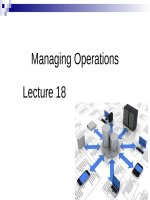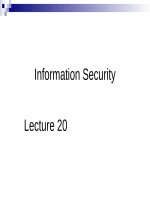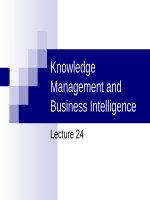Lecture Business management information system - Lecture 7: Strategic uses of information technology
Bạn đang xem bản rút gọn của tài liệu. Xem và tải ngay bản đầy đủ của tài liệu tại đây (504.63 KB, 50 trang )
Strategic Uses of Information
Technology
Lecture 7
Today lecture summary
n
Use of the Internet by businesses set off a revolution in
the use of IT, so that utilizing the Internet to conduct
business became the strategic use of information
technology.
n
The questions that remain are:
¨ Has the revolution ended, or
¨ Does an even larger revolution loom?
¨ Does IT still matter?, and
¨ What sorts of strategic uses are companies making?
Today lecture summary
n
Strategic roles of IT fall into one of three categories:
1.
“working inward” (improving a firm’s internal
processes and structure)
2.
“working outward” (improving the firm’s products
and relationships with customers) and
3.
“working across” (improving its processes and
relationships with its business partners)
Today lecture summary
n
Grainger, GE Power Systems, Wire Nova Scotia, The
Shipping Industry, Cisco Systems and UPS Supply
Chain Solutions, Semco, S. A., A Day in the Life of an Elancer, General Mills and Land O’ Lakes, Sara Lee
Bakery Group, and Dell Computer serve as examples of
how companies are using information systems in
strategic roles
Contents
n
Introduction
¨ History of Strategic Uses of IT
¨ Whither the Internet Revolution?
¨ The Cheap Revolution
¨ Episode Two: Profitability Strikes Back
¨ Does IT Still Matter?
n
Working Inward: Business-to-Employee
¨ Building an Intranet
¨ Fostering a Sense of Belonging
Introduction
n
Use of the Internet by businesses in mid/late ’90s set off
a revolution in the use of IT
¨ Utilizing the Internet to conduct business became the
strategic use of IT
n Strategic = having a significant, long-term impact
on a firm’s growth, industry and $$
n
What now?
¨ Dot-com crash
¨ A larger revolution to come?
¨ Does IT still matter?
¨ What strategic uses are companies making of IT (esp.
the Internet)
Introduction
Last 20 Years – Strategic Uses of IT
n
n
1st edition
¨ Mid 1980s, hot topic = end user computing (working
inward)
n Help employees learn about PCs
2nd edition
¨ Late ’80s strategic use focused outward to gain
competitive advantage
n e.g. Merrill Lynch cash management account
¨ Now considered ‘normal’ = competitive
necessity Vs. competitive advantage
Introduction
Last 20 Years – Strategic Uses of IT cont.
n
3rd & 4th editions (1990s)
¨ Strategic use attention turned inward to reengineering
business processes
n Intent = not to automate existing processes but to
totally redesign how the enterprise operated
¨ Good idea but many failed as they were ‘lay-off’
plans
n Introduction of ERP systems was also aimed at
internal operations, specifically providing single
sources of data enterprise-wide
Introduction
Last 20 Years – Strategic Uses of IT cont.
n
3rd & 4th editions (1990s) cont.
¨ Internet’s potential becoming evident
n Dot-coms = looked at its outward use to gain a
competitive advantage
n Most established firms initially used the Internet
technology internally, building intranets to improve
company processes
¨ Publishing e-forms
¨ Accompanying workflow processes
Introduction
Last 20 Years – Strategic Uses of IT cont.
n
5th edition (late ’90s)
¨ Use
of the Internet for business underway
n Bursting of the dot com bubble
n E-Business has become more reality based
n Integration of the Internet into how companies
work has proceeded
Introduction
Last 20 Years – Strategic Uses of IT cont.
n
6th edition (early ’00s)
¨ Theme
= leveraging traditional operations by using
the Internet to work more closely with others
n
Innovations of the dot-coms created competitive
challenges for ‘bricks and mortar’ firms
–
Their ‘strike back’ is essentially the theme for
this 6th edition
Introduction
Last 20 Years – Strategic Uses of IT cont.
n
7th edition (2005)
¨ “Something
n
has changed”
Especially with regards to the use of IT for
competitive advantage
Introduction
Last 20 Years – Strategic Uses of IT cont.
¨ Some
may question IT’s ability to give companies a
competitive edge but it is absolutely necessary for
competitive parity (necessity?)
n
Being used strategically:
¨ Inward
¨ Outward
¨ Across
What Is the Internet?
n
n
A network of networks, joining many government,
university and private computers together and providing
an infrastructure for the use of E-mail, bulletin boards,
file archives, hypertext documents, databases and other
computational resources
The vast collection of computer networks which form and
act as a single huge network for transport of data and
messages across distances which can be anywhere
from the same office to anywhere in the world.
What Is the Internet?
n
Technically, the Internet is a global information system
defined by three characteristics:
•
A network composed of computers and other devices
that are logically linked together by a unique address
space based on the Internet Protocol
What Is the Internet?
•
A network where network devices are able to support
communications using TCP/IP (Transmission Control
Protocol/Internet Protocol) or other compatible protocols
•
A network that provides high-level services layered on a
communication and network infrastructure
What Is the Internet?
The largest network of networks in the
world.
n Uses TCP/IP protocols and packet
switching .
n Runs on any communications
substrate.
n
Brief History of the Internet
n
n
1968 - DARPA (Defense Advanced Research Projects Agency)
contracts with BBN (Bolt, Beranek & Newman) to create
ARPAnet
1970 - First five nodes:
¨
¨
¨
¨
¨
n
n
UCLA
Stanford
UC Santa Barbara
U of Utah, and
BBN
1974 - TCP specification by Vint Cerf
1984 – On January 1, the Internet with its 1000 hosts
converts en masse to using TCP/IP for its messaging
1945
1995
Memex
Age of
eCommerce
Begins
1995
TCP/IP
Internet Created
Named
1972
and
Goes
WWW TCP/IP
Mosaic Created 1984
Created 1989
1993
ARPANET
1969
Hypertext
Invented
1965
Conceived
A
Mathematical 1945
Theory of
SiliconCommunication
First Vast Chip
1948
Computer 1958
Network
Packet
Envisioned
Switching
1962
Invented
1964
A Brief Summary of the
Evolution of the Internet
The Creation of the Internet
n
The creation of the Internet solved the following
challenges:
¨ Basically
inventing digital networking as we know it
¨ Survivability
of an infrastructure to send / receive
high-speed electronic messages
¨ Reliability
of computer messaging
Introduction
Whither the Internet Revolution?
n
n
Internet frenzy peaked in 2000
Is the Information Revolution dead?
¨ Not
§
§
§
if history is any guide
British Railway Revolution – mid 1800s
10 fold increase after the boom
¨ During boom = great excitement and small companies
flourished
¨ After = glamour gone. Business became serious and full
of hard work
¨ Industry became orderly and profits began to reflect real
returns
Connecting industries
¨ Race for space followed by the ‘real deal’
Introduction
Whither the Internet Revolution? cont.
n
We are now in a period where organizations are rearchitecting themselves around Internet technologies
¨ Tearing down old structures as they go
n
Real gains will come when Internet technology adapts to
organizations and people
¨ When the technology disappears and becomes part of
life
It will be ‘quiet’ compared to frenzy of ’99/00 but many
think it will be a giant revolution
n
Major Internet Services
•
E-mail:
Person-to-person messaging; document sharing
•
Usenet newsgroups:
•
Discussion groups on electronic bulletin boards
•
Major Internet Services conti..
•
LISTSERVs:
•
Discussion groups using e-mail mailing list servers
•
Chatting and instant messaging:
•
Interactive conversations









